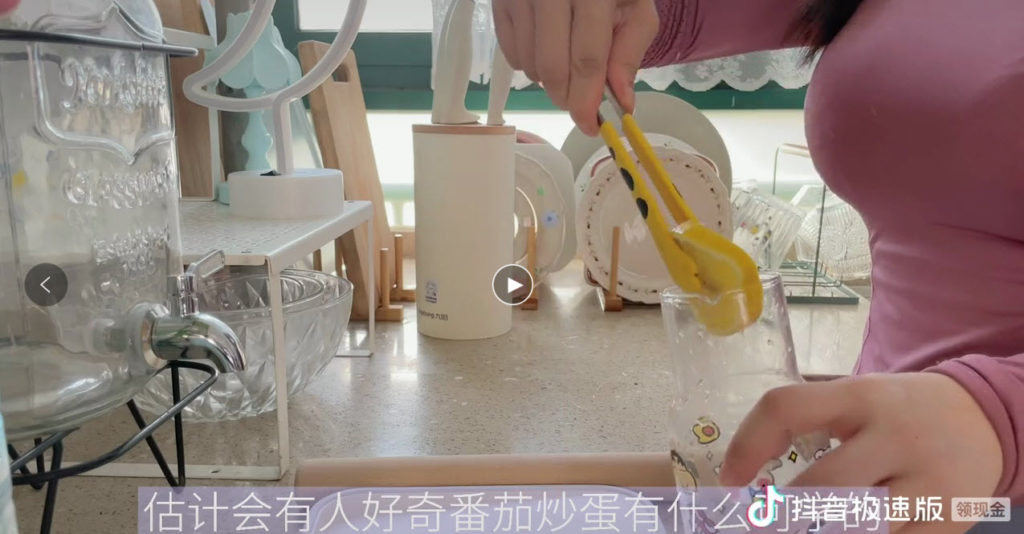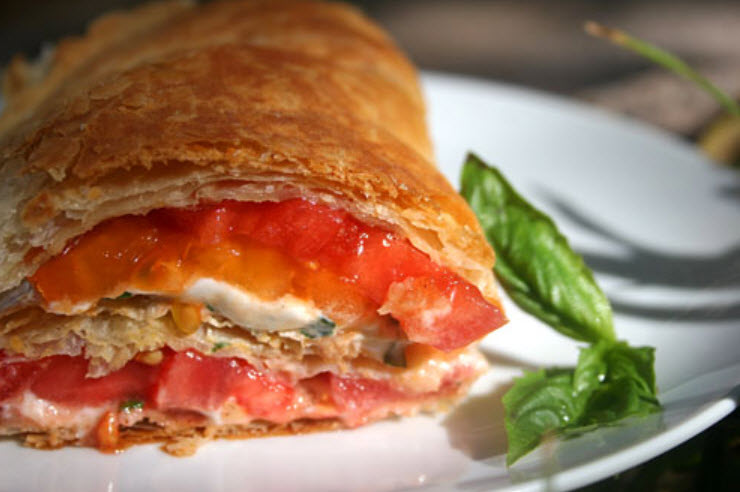Here’s a “master list” of heirloom tomatoes that I have collected off the internet. I have extracted the data from heavy advertisement saturated websites, and other pay-wall blocked for-profit venues. Whether or not you enjoy heirloom tomatoes, I hope that this list will be beneficial to you.
What is a Heirloom Tomato…
An heirloom tomato (also called heritage tomato in the UK) is an open-pollinated, non-hybrid heirloom cultivar of tomato. They are classified as: family heirlooms, commercial heirlooms, mystery heirlooms, or created heirlooms. They usually have a shorter shelf life and are less disease resistant than hybrids. They are grown for a variety of reasons: for food, historical interest, access to wider varieties, and by people who wish to save seeds from year to year, as well as for their taste.
But first…
I wish that I was as talented as some of the women that I know. They have a real understanding, or a “feel” on how food comes together and mates with other foods. And they have this kind of innate ability that I seem so very clumsy with. And they seem to know which is the right tomato for the right application.
Never the less, I do know that I like to eat. I know that when I go to a store, I like to smell the produce, and if I am growing things, I am always smelling the tomatoes on the vine. There’s a real connection between scent and taste. Seriously.
Here’s some pictures to illustrate what you can do with heirloom tomatoes…
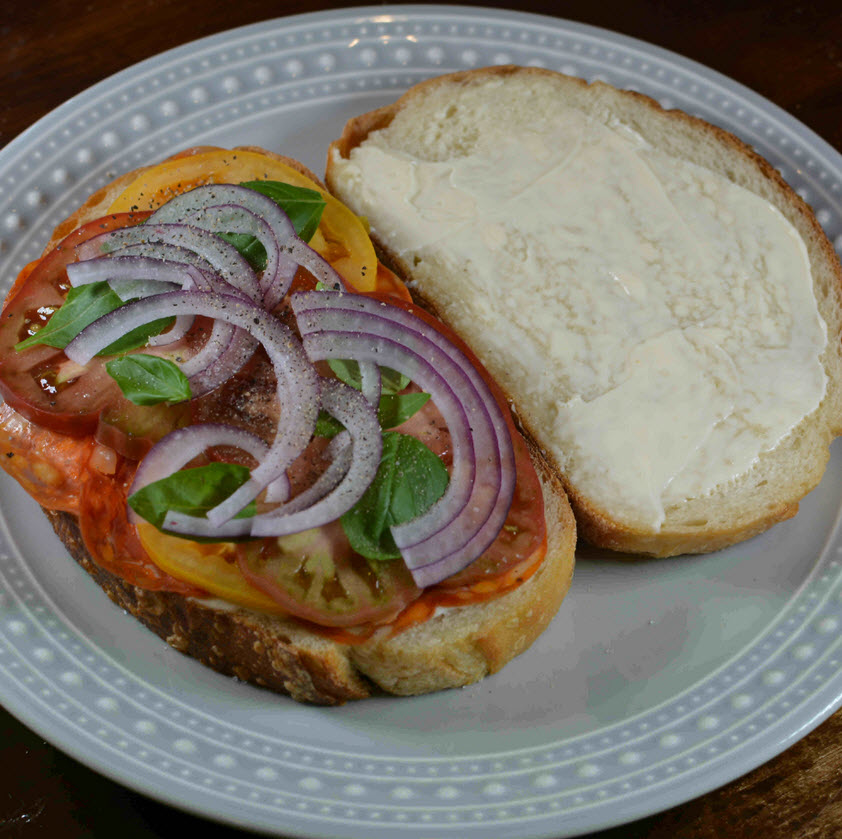
I strongly argue that the best thing to do with heirloom tomatoes is to eat them. After all, they are so very delicious.

Not a full sandwich, but tasty never the less…
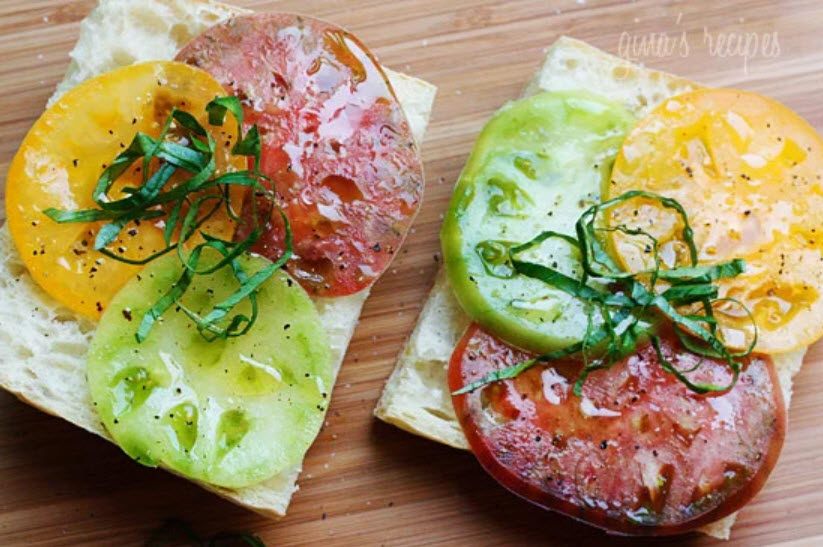
A recipe
Here’s a great heirloom tomato sandwich recipe. Yum!

And the details…
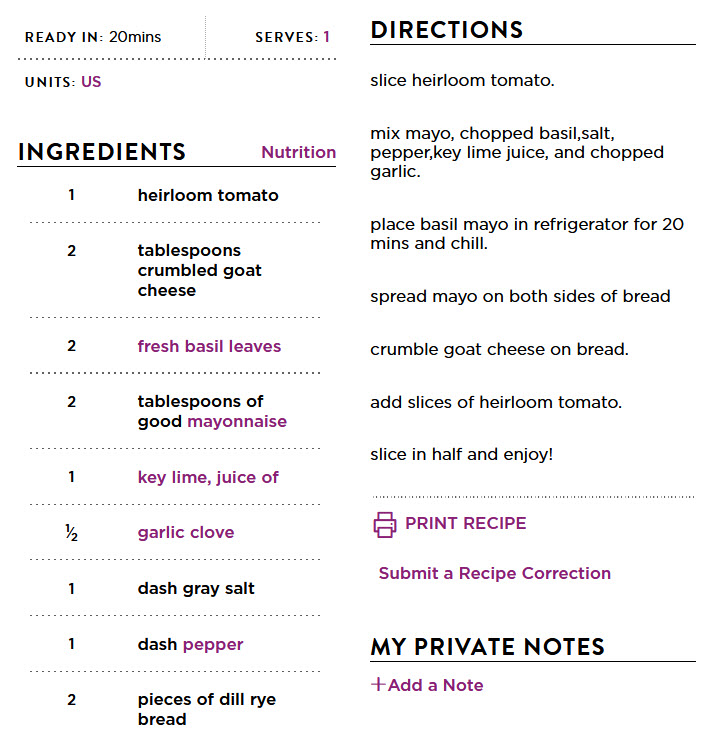
A story…
When I was around 12 years old, I was given free reign in the family garden, and there, every day I would how the ground, pull the weeds, water the plants and so forth. I developed a real love for the plants. With tomatoes, and zucchini being my favorites. Peppers and cucumbers grew too slowly for my tastes, while onions and carrots remained hidden under the ground.
There, every day during the middle to late summer I would pick my tomatoes and was amazed at the enormous big bounty and delicious flavor that they provided.
I remember my mother coming in to the kitchen one day and asking what “the heck” I was doing. Why, I had made a thick, fresh, tomato sandwich with mayonnaise, salt and pepper on plain white (store bought) bread. And I was busily smunching down on it over the sink, with the tomato drippings falling into the sink. I guess she must have thought me to be so silly.
But it was glorious.
And I still remember that day. I still remember how great it tasted. I still remember how wonderful it was.
In China…
Chinese stir fry tomatoes and eggs 番茄炒蛋.
One of the top favorite foods is this dish called eggs and tomatoes. It’s not prepared American style, where you simply scramble the tomatoes in with the eggs. No NO. Instead, there is a certain procedure and the results are glorious.
Here’s what the dish looks like…

Here’s a video of how it is done…
…So sexy! So delicious! So wonderful!
Here’s a recipe…
Some comments
From HERE.
Because of the many different regions in China, defining a Chinese national dish is nearly impossible. But if you ask Chinese people their favorite childhood dish, stir fried tomatoes and eggs is THE ONE that everyone will agree on!
There’re a few variations of this dish. I sometimes stir fry the tomatoes with tofu or beef.
You won’t find this dish in American-Chinese restaurants often, but it’s definitely a staple dish served with rice at home.
Hint: In China, just about every restaurant will serve this dish on the menu.
If you are just starting to learn how to cook in a wok, this is a great recipe for a beginner.
Back in Guangzhou, China, there’re fresh fruits and vegetables all year long and tomatoes are in season most of the time. My mom usually doesn’t add ketchup to this dish, but I do that when tomatoes are out of season in Cleveland. This helps enrich the flavor of the tomato sauce and enhance the color of the dish.
Here’re a few things to know when cooking this dish:
-
- Tomatoes must be fresh, ripe and soft. Ripe tomatoes make the sauce flavorful and juicy.
- Pealing off the tomato skin will help soften the flesh and make them melt in your mouth.
- Serving the dish with rice is a must.
The Heirloom Tomato list…
These determinate tomatoes grow in abundant crops. They come with low acidity.
The semi-determinate tomatoes are characterized by bushy plants. Originating in Russia, they are suited to colder environments.
These are the earliest semi-determinate plum-shaped tomatoes. They are suitable for colder weather.
The indeterminate tomatoes come from Germany. They are characterized by fruits with few seeds.
The tomatoes are indeterminate. They take up to 70 days to mature and at the moment, they are popular across the UK.
With Ukrainian roots, the semi-determinate tomatoes are characterized by a sweet flavor.
The indeterminate heirloom tomatoes are known for their juicy flesh. They are used for sauces and fresh eating.
These determinate tomatoes were bred by De. Jim Gilbert of Hawaii. They have a deep red color and they are known for their sweet flavor.
With French origins, the semi-determinate tomatoes are recognizable with their long pointed shape. They are suitable for sauces.
These bi-color tomatoes have an indeterminate profile. The yellow-red tomatoes come with fruit sizes of 16oz.
With rich pink color, the indeterminate tomatoes are suitable for sandwiches and salads. They resist cracking.
With a distinct green look, the indeterminate tomatoes take at least 80 days to mature. They were first introduced in 1993 in Wisconsin.
With a rich flavor, the indeterminate tomatoes are meaty. They are suited to warmer climates.
The indeterminate tomatoes have a sweet taste. Their fruits can grow up to 1 pound.
The indeterminate tomatoes are made for hot and humid climates. The tomatoes have disease resistance.
The green indeterminate tomatoes are sweet. The beefsteaks also have a yellow tint.
Named after the Aurora Borealis, these Russian determinate tomatoes produce heavy crops. They are suitable for colder environments.
As their name suggests, the indeterminate tomatoes come are shaped like pears. They are known to be very productive.
The indeterminate tomatoes come from Russia. When they are ripe, they have a pale orange color.
B
These determinate tomatoes come from Yugoslavia. They are used in sauces, sandwiches or canning.
These determinate tomatoes come in 4-inch fruits. Their name comes from their light banana color.
The red determinate tomatoes have a size of 9in for the fruit and 4feet for the plant. They are resistant to Verticillium.
The determinate tomatoes come from the Beaverlodge Research Center in Canada. With only 54 days to reach maturity, the tomatoes are suitable for colder environments.
Dating back hundreds of years, the indeterminate cherry tomatoes have a sweet taste. The tomatoes originate in Germany.
The indeterminate tomatoes have a pink color. They have a tangy flavor.
The yellow and red indeterminate tomatoes have low acidity. They are shaded by large leaves.
The indeterminate vines are suitable for sandwich tomatoes. The fruits have a deep red color.
The meaty indeterminate tomatoes are rich in taste. The fruits are large and suitable for slicing.
The indeterminate beefsteak tomatoes have a mildly sweet flavor. They have a distinct red-green color.
Developed by North Dakota University, the determinate tomatoes produce dwarf compact plants. They are suited to damp cold weather.
The indeterminate tomatoes grow up to 14 ounces. They were exported from Ukraine by Marina Danilenko.
The indeterminate tomatoes ripen through the season. They can take up to 75 days to reach maturity.
Bearing the name of the Crimean Peninsula, the indeterminate tomatoes reach maturity within 80 days.
Black Plum indeterminate tomatoes come from Russia’s Marina Danilenko. They can be used for a rich pasta sauce.
The indeterminate tomatoes have a red-black color. They are known for their juicy profile.
With attractive marble flesh, the tomatoes come from seed woman Marina Danilenko. The determinate tomatoes are medium in size.
Known as Japanese or Russian Black Trifele, the indeterminate tomatoes take between 70 and 80 days to mature.
The 1-in yellow indeterminate tomatoes have a sweet flavor. They come from Germany.
The indeterminate tomatoes are known for their rich crops. The fruits have a rich flavor.
The indeterminate tomatoes were first introduced in 1983 in Indiana. They are known for their bright yellow color.
These tomatoes are known for the size. They can reach a weight of up to 4lbs. The indeterminate tomatoes are common in the US.
With a beefsteak profile, the indeterminate tomatoes have a deep pink-red color. The fruit size can reach 16oz.
The indeterminate tomatoes take up to 85 days to mature. They have a distinct yellow look with red swirls.
The indeterminate Bonny Best produces fruits of up to 8 ounces. The fruits are suitable for all purposes.
The red indeterminate tomatoes come in weights of up to 16 ounces. The color of the fruits is red with dark undertones.
The indeterminate tomatoes were first introduced in 1889. They were offered to Johnson and Stokes by a customer in Ohio.
With a pink color, the indeterminate tomatoes are rich in flavor. They are not heavy producers.
The indeterminate tomatoes come with a distinct yellow color. The fruits weight from 12 ounces to 2 pounds.
Popularly called Pink Brandywine, the tomatoes are rich in flavor. Their indeterminate fruits ripen through the season.
The determinate tomatoes were introduced by Luther Burbank. They are high in amino acids.
The indeterminate tomatoes are small at 4 inches. The hollow interior makes them look similar to peppers.
These determinate red tomatoes are already popular for shorter growing regions. The plant grows up to 3 feet.
C
The determinate tomatoes are suitable for salads and sandwiches. They have a deep red color.
The indeterminate tomatoes come with a distinct bright orange color. They are used in soups and sauces.
With red-black color, the indeterminate tomatoes are ripe late in the season. They are suitable for slicing.
With a distinct green color, the juicy indeterminate tomatoes are best served fresh.
The indeterminate tomatoes come with a brownish red color. The tomatoes have regular leaves.
With a dark red color, the indeterminate tomatoes grow in clusters. The plant height reaches 6 feet.
The indeterminate tomatoes are great fresh or dried. They are considered very productive.
The beefsteak indeterminate tomatoes have a deep pink color. The fruit size varies between 1 and 2 lbs.
With an orange color with red stripes, the indeterminate tomatoes have a distinct look. They originate in the US.
The determinate tomatoes have a rich flavor. They are suitable for areas with a short growing period.
Originating in Italy, the indeterminate tomatoes have a slight tart flavor. Their color is bright red.
The determinate tomatoes are very productive. They were introduced by Baker Creek Heirloom Seeds in 2004.
The indeterminate Crimson Cushion takes 95 days to mature. The fruits can reach up to 2 pounds in weight.
The indeterminate tomatoes have a delicious flavor. They were introduced to the US by Yasha Crnkovic.
Rich in production, the indeterminate tomatoes can measure up to 4 inches.
The red indeterminate tomatoes have a juicy profile. The tomatoes can be traced back to Czechoslovakia.
D
The tomatoes fruits come in variable shapes. The indeterminate tomatoes grow in clusters of 7 fruits.
The tomatoes are believed to come from Germany. The indeterminate tomatoes grow pink fruits of up to 1lbs.
Going back to the 1930s, the indeterminate yellow tomatoes have a mild taste. They are suitable for slicing.
With a yellow-orange color, the indeterminate tomatoes can be traced back to 1929.
Originating in Bulgaria, the indeterminate tomatoes have a bright red color. They have a robust tomato flavor.
With a distinct golden color, the indeterminate tomatoes have a meaty flesh.
Growing up to 3 pounds, the indeterminate tomatoes have a mild flavor. They can be traced back to 1920.
As a result of the Dwarf Tomato Project, the determinate tomatoes have a hybrid profile. They are a cross between Roza Vetrov and Anna Banana Russian. The tomatoes have a balanced sweet flavor.
Developed by the Dwarf Tomato Project, the determinate tomatoes are a cross between Dwarf Wild Fred and Brad’s Black Heart. They have a purple-black color.
E
Introduced in New Jersey in 1900, the indeterminate tomatoes grow come in clusters of 4-5 ounce fruits.
With few seeds, the determinate tomatoes are suitable for canning. They take 60 days to mature.
These determinate tomatoes were first introduced in 1950. They are suitable for container-based growing.
The indeterminate tomatoes originate in the Elbe River’s area in Germany. They come with a sweet and tart flavor.
The red determinate tomatoes are suitable for canning or snacking. They can grow up to 2”.
Believed to come from Germany, these indeterminate tomatoes are recommended for humid areas. They have a distinct vivid red color.
F
The semi-determinate tomatoes come in a pear shape form with a yellow-orange color. They are suitable for specialty salads.
With fruits of up to 7 inches, the indeterminate tomatoes can easily be processed. They can be the base for salsa sauces.
Up to 90 days is needed for the tomatoes to reach maturity. The indeterminate tomatoes have been developed in 1894.
Traced back to France, the indeterminate tomatoes can be grown in colder climates. The fruits have a deep red color.
The pointed tomatoes are available early in the season. The indeterminate tomatoes grow up to 6oz.
The indeterminate tomatoes come with fruit sizes of up to 1oz. They are suitable for salads.
G
The tomatoes come in a yellow color. They are indeterminate and distinctly fuzzy, as their name suggests.
The indeterminate tomatoes take up to 65 days to mature.
The meaty fruits of the tomato can grow up to 2 pounds. The indeterminate tomatoes take up to 85 days to mature.
The indeterminate tomatoes come with low acidity. The fruits have a pink color.
The indeterminate German heirloom has a strawberry color. They come with a rich flavor.
The semi-determinate tomatoes are suitable for early season harvest. They are consumed fresh.
With a slightly flattened shape, the tomatoes grow up to 10oz. The indeterminate tomatoes grow up to 4 feet.
With larger orange-yellow fruits, the indeterminate tomatoes are known for their large size and good flavor.
The indeterminate tomatoes have a meaty profile. The fruits can reach up to 2 pounds in weight.
With a sweet taste, the tomatoes have a deep pink color. The tomatoes can vary from 1 to 3 pounds.
The meaty tomatoes are flavorful. The indeterminate tomatoes are suitable for salads and sandwiches.
Suitable for canning, juicing or slicing, the semi-determinate tomatoes are a cross between Wasatch Beauty and Pepper tomatoes.
The yellow-red tomatoes have a rich flavor. Their juicy profile recommends them for fresh eating.
The determinate cherries have a yellow to orange color. They are suitable for snacking.
With up to 80 days needed to reach maturity, the indeterminate tomatoes offer hundreds of fruits per plant.
The indeterminate ribbed tomatoes come in sizes from 8 to 16 ounces. They have an old-fashioned taste.
The average flavor tomatoes are indeterminate. They are average in flavor intensity.
The determinate tomatoes have a distinct olive yellow color. The fruit ripens within 2 weeks.
With a distinct look, the determinate tomatoes have a green color with yellow stripes. They have a long pointed shape.
The determinate yellow-orange tomatoes ripen slowly. They are suitable for high altitudes.
The indeterminate tomatoes are known to be very productive. They were first bred in 1983 by Thomas Wagner.
These determinate heirloom tomatoes come from Siberia. They produce 2-3 inch fruits.
H
With a mildly sweet profile, the indeterminate tomatoes come from a seed company in Indianapolis. They are used in salads.
The beefsteak indeterminate tomatoes are known for their pineapple resemblance. The tomatoes are mildly sweet.
The determinate tomatoes are bred to resist hot water. They are tolerant of the tobacco mosaic virus.
The determinate red tomatoes are suitable for canning. They take 76 days to mature.
The mid-season determinate tomatoes are used for sauced and canning. They were developed for Eastern Canada and Northeast U.S.
The determinate heirloom tomatoes are used for canning and sauces. They are slightly larger than other Heinz varieties.
The large beefsteak indeterminate tomatoes can reach weights of up to 2 pounds. They have a yellow-orange color.
The determinate tomatoes are thriving in hot and humid areas. They are resistant to cracking.
With yellow and red, the tomatoes look distinctly juicy. The tomatoes are indeterminate, originating from Ohio.
The indeterminate tomatoes resist cracking. They originate from a village near Budapest.
I
Growing in clusters, the indeterminate tomatoes reach fruit sizes of 0.5oz. They are suitable for salads and decoration.
The yellow indeterminate tomatoes ripen through the season. They are rich in flavor with moderate acidity.
The red tomatoes come with a sweet flavor. These indeterminate tomatoes take between 70 to 80 days to ripe.
The indeterminate tomatoes grow up to 1lbs. They are suitable for slicing and sandwiches.
The Italian indeterminate heirlooms have a meaty flesh. They are suitable for sandwiches or served fresh.
The determinate vines bear elongated fruits. They are larger than Roma tomatoes. The tomatoes are also higher in sugar.
J
Shaped as pears, the tomatoes have a red-black color. They are resistant to cracking.
With distinct potato leaves, the indeterminate tomatoes are rich in flavor. They are often canned.
Great for drying or roasting, the indeterminate tomatoes are known for their deep orange color. They come from France.
Rich in flavor, the indeterminate tomatoes are eaten fresh. The tomatoes were introduced in 1914.
The indeterminate heirloom tomatoes were released in 1943 by the Burpee Seed Company.
K
The determinate tomatoes are a bred of the University of Hawaii. With a sweet flavor, the tomatoes were bred to resist bacteria and viruses.
Probably originating from Germany, the indeterminate tomatoes have red beefsteak fruits which can grow up to 1.5 pounds. Double fruit is common with the low acidity tomatoes.
The indeterminate tomatoes have a distinct orange glowing color. They can take up to 90 days to mature.
With an oval shape, the indeterminate tomatoes have a meaty flesh. They are recognized due to their distinct orange color.
Originating in the Kolb Greenhouse of Storm Lake, the indeterminate tomatoes have a pink color. They are rich in flavor.
L
These tomatoes are very productive. With fruits between 1 and 2 inches, the indeterminate tomatoes are used in salads or eaten fresh.
With a transparent yellow-green color, the tomatoes are indeterminate. They are known for their resilience in cold and wet weather.
These potato leaf indeterminate tomatoes were first collected by Lillian Bruce in Tennessee.
The determinate tomatoes stay small. As a result, they can be grown in containers.
These red tomatoes have an indeterminate growth habit. They are named after Alexander Livingston’s seed trade.
These semi-determinate tomatoes were introduced in 1979. They are suitable for winter storage.
M
These pink tomatoes are indeterminate. They are sweet in flavor.
With meaty fruits, the indeterminate tomatoes are plum-shaped. The tomatoes reach up to 6 feet in height.
With a red color, the determinate tomatoes are suitable for small gardens in cooler climates.
The juicy indeterminate tomatoes come with an orange-red skin. They are suitable for canning.
The indeterminate tomatoes are resistant to disease. They come in a dark red color.
With a distinct Italian profile, the determinate tomatoes are known to fall off when fully ripe.
Similar to beefsteaks but smaller in size, the indeterminate tomatoes can grow up to 2oz.
Smaller than regular indeterminate cherry tomatoes, Matt’s Wild Cherry come from Mexico’s wild tomatoes.
These indeterminate orange tomatoes also feature distinct orange stripes. They have juicy flesh.
The determinate tomatoes have a sweet flavor. They are suitable for sauces.
Bering very productive, the indeterminate tomatoes are rich in flavor. Their size varies between ½-¾ inches.
The indeterminate smooth tomatoes grow in clusters of 4 to 6. The tomatoes have a rich flavor.
As their name suggests, the tomatoes come in a pink color. The indeterminate tomatoes have a juicy profile.
With inexpensive seeds, the indeterminate tomatoes take 80 days to mature.
With a bright orange color, the indeterminate tomatoes ripen through the season. They have a distinctly-solid flesh.
These beefsteak indeterminate tomatoes used to pay off a mortgage.
These indeterminate tomatoes have a rich taste and slightly flattened shape. They are suitable for cold climates.
The indeterminate tomatoes grow up to 1lbs. They come with high sugar content and with a yellow color with red stripes.
The red indeterminate tomatoes resist drought. They are also disease-resistant.
N
The determinate tomatoes are suitable for sauces and soups. They have a tangy flavor.
These determinate tomatoes ripen over a two-week period. They can be traced back to 1983.
The beefsteak indeterminate tomatoes are rich in flavor. Their fruits grow large, up to 16oz per piece.
The determinate tomatoes were introduced in 1919. They are a cross between Ponderosa and Dwarf Champion.
The determinate tomatoes are small but pear-shaped. Their fruits grow up to 0.7oz.
The determinate tomatoes are suitable for cooler climates. They mature in 63 days.
With a determinate profile, the tomatoes are sweet and suitable for early crops for cooler seasons.
Free from blemishes, the indeterminate tomatoes have a brown-red color. They are very productive.
O
The indeterminate red and yellow tomatoes come with few seeds. The color of the skin is also visible in the flesh of the tomatoes.
The indeterminate tomatoes are suitable for hot climates. They come with thick skin which resists cracking.
The indeterminate beefsteaks have a rich sweet flavor. The fruits reach up to 2 pounds.
Growing between 3 and 6 inches, the fruits of the tomatoes have few seeds. The indeterminate tomatoes hold well on the vine.
With a distinct orange color, the indeterminate tomatoes have fruits of up to 6oz. They are plum-shaped.
The beefsteak indeterminate tomatoes have a dark orange color. They grow up to 12 oz per fruit.
The determinate vines are recommended for early growth. The fruits come with a low number of seeds.
P
With a rich flavor, the indeterminate tomatoes take 80 days to mature.
With a dark red to black color, the indeterminate tomatoes mature in 90 days. They come from Russia.
With a pink look and a fuzzy skin, the indeterminate tomatoes have a refreshingly sweet flavor.
The determinate wines can be grown in dry regions. The tomatoes are juicy and used for canning.
Originating in Russia, the orange tomatoes can reach 1lbs in weight. The indeterminate tomatoes are blemish-free.
Traced back to the 1890’s France, the indeterminate vines produce until frost. They have a meaty texture.
The yellow skin with red streaks is what inspired the names of these indeterminate tomatoes. They come in large sizes.
These distinct indeterminate tomatoes are suitable for slicing. They come in a light pink color.
The indeterminate vines are known for their 1-2 pound size. They come with a firm texture.
At 3oz, the indeterminate tomatoes have the size of a ping pong ball. The tomatoes are suitable for salads.
The indeterminate tomatoes look similarly to lemons. Their taste is mild-citrusy.
The ribbed indeterminate tomatoes come with a 1-pound weight. The tomatoes have a rich flavor.
The indeterminate tomatoes can be traced to 1891. They usually come in sizes between 1 and 2 pounds.
With rich red color, the indeterminate tomatoes are crack-resistant. They are suitable for canning.
The plum-shaped indeterminate tomatoes have a rich taste. They are suitable for drying.
With a dark pink-purple color, the indeterminate tomatoes are rich in taste. They have firm flesh.
With a dark marooned color, the indeterminate tomatoes have a complex flavor. They grow in crops of 3-inch tomatoes.
The red indeterminate tomatoes have a sweet flavor. They are distinctly pear-shaped.
Probably originating in Mexico, the indeterminate tomatoes come with a translucent yellow color. They are very productive.
These determinate heirloom tomatoes are suitable for higher altitudes and colder climates. They are used for canning and salads.
These black determinate tomatoes were developed by Tom Wagner. The cherry tomatoes still have a novelty profile as they were introduced around 2.000.
The Italian tomatoes are suitable for drying. They are determinate and they produce plum-shaped fruits.
R
The semi-determinate round tomatoes have a red color. They mature in 75 days.
The miniature tomatoes take at least 65 days to mature. Their indeterminate profile also comes with regular leaves.
The indeterminate tomatoes originate in Florida. They are characterized by productive plants.
With pear-shaped fruits, the indeterminate tomatoes originate in Philadelphia. They are suitable for drying.
The heart-shaped indeterminate tomatoes are recommended for slicing. They have a rich fruity taste.
Dating back to the 1700s, the indeterminate tomatoes can deal with early blight. Their fruits are distinctly blemish-free.
With 54 days needed to reach maturity, the determinate tomatoes have a sweet flavor. They are consumed fresh.
The indeterminate beefsteak tomatoes can be consumed fresh. They reach 10oz per fruit.
The small ¼in indeterminate tomatoes come with a rich taste. They are consumed fresh.
Discovered on the fields of California, the indeterminate tomatoes come with a distinct red look with orange stripes.
Selected from Livingston’s Beauty, the indeterminate tomatoes have a pink color. The plant reaches 6 feet.
Originating in Germany, the indeterminate tomatoes can bear fruits of up to 1in.
Suitable for hot climates, the indeterminate tomatoes have a red color. They make fruits of up to 8oz.
The indeterminate tomatoes are known for making good sauces. Their fruits weigh between 2 and 3 ounces.
The indeterminate tomatoes have an Amish origin. They are rich in flavor.
These pink determinate tomatoes have a balanced flavor. They are a cross between Budai Torpe and Stump and one of the results of the Dwarf Tomato Project.
These bright red tomatoes can grow up to 6 ounces. The indeterminate fruits are used for sauces.
The semi-determinate yellow-orange tomatoes were developed by William Woys Wearer. They are suitable for salads.
The indeterminate heirloom tomatoes are a cross. They come from Marglobe and J.T.D.
S
With a sweet flavor, the indeterminate tomatoes are used for sauces. They have average productivity.
The indeterminate tomatoes take 85 days to mature. Their seeds are available for purchase.
Originating from Greece’s Santorini, the indeterminate tomatoes are small by nature.
The indeterminate tomatoes were gifted in 1989’s Siberia by a man called Sasha. They have been seen as one of the best early producing tomatoes in the world.
The indeterminate vines are very productive. They are known for heavy crops and banana-like shape.
With a pink color, the plum-shaped indeterminate tomatoes are used in pasta. Their fruits vary between 4 and 6 inches.
With a meaty texture, the indeterminate tomatoes come with weights of up to 1 pound. They can be grown in small gardens.
The oval red-orange indeterminate tomatoes come from Germany’s Manheim family. The tomatoes resist cracking.
The yellow-orange determinate tomatoes are medium-sized. They mature in 80 days.
Growing up to 6 ounces, the indeterminate tomatoes originate in Sheboygan, Wisconsin. They are very productive.
These determinate tomatoes have fruits of up to 3 inches. They are not to be confused with Siberia tomatoes.
The determinate red tomatoes are acclimatized to cooler climates. They are used as slicing tomatoes.
These determinate tomatoes grow on 24” plants. They have Russian roots.
The indeterminate tomatoes are believed to originate in Poland. They have thin skin susceptible to cracking.
The determinate tomatoes were introduced in Edmonton, Canada. They are suitable for cooler areas.
With a rich tomato flavor, the indeterminate plant grows to 4 feet producing 10oz fruits.
The indeterminate tomatoes are red with orange stripes. The tomatoes are a cross between Antique Roman and Banana Legs.
The determinate red tomatoes produce 2-inch fruits. They are suitable for salads.
Producing well in Northern climates, the indeterminate tomatoes are believed to originate from former Czechoslovakia.
Made for salads or eating fresh, the determinate tomatoes produce until frost. They have thin skins.
The distinct red-yellow indeterminate tomatoes are made for slicing. They have a tart flavor.
With 62 days needed to reach maturity, the indeterminate tomatoes have distinct potato-type leaves.
With upright stems, the determinate vines are made for colder environments. They are recommended for early harvests.
Growing in clusters of 12 fruits, the indeterminate German tomatoes have a sweet taste. They are characterized by vivid red color.
The elongated Italian indeterminate tomatoes are used for sauces and canning. The fruits can reach weights of 10 ounces.
The globe-shaped indeterminate tomatoes are suitable for hot weather. They are used for canning or consumed fresh.
With high sugar content, the indeterminate tomatoes are sweet. The sweet tomatoes grow in clusters of up to 20.
The small 5-ounce tomatoes originate in Switzerland. They are suitable for cold weather.
The red determinate tomatoes have regular leaves. They come from Indian gardener Surender Katta.
The determinate red tomatoes have bushy, regular leaves. They come from Israel.
With an indeterminate profile, they are used as a garnish. They are considered one of the best red currant tomatoes.
T
With a distinct tangerine shape, the indeterminate tomatoes have a tart-citrus flavor. The fruits grow up to 7 ounces.
The tomatoes have a green color. The indeterminate tomatoes are very sweet.
The determinate yellow-orange tomatoes are suitable for hot and humid regions. They are good for slicing and sandwiches.
The Greek indeterminate tomatoes have medium acidity. They resist cracking and high temperatures.
With a distinct look with yellow stripes, the tomatoes measure up to 2 inches. They have a tangy-tart taste.
The red determinate tomatoes have an Italian elongated shape. They have a rich flavor and they can be used for canning.
With only 45 days needed to reach maturity, the determinate tomatoes were developed by the University of New Hampshire.
The semi-determinate tomatoes originate from Southern Italy. They are suitable for dryer regions.
Being indeterminate, the cherry tomatoes are considered to be very productive. The plants are very vigorous.
These round tomatoes can grow up to 7 ounces. The indeterminate tomatoes are used for slicing as a result.
Originating from Arkansas, the indeterminate tomatoes come with regular leaves.
The meaty indeterminate vines grow up to 25 feet. The fruits are used for slicing and canning.
The round indeterminate tomatoes come with a distinct red color. They were developed in Israel.
The 3” pink tomatoes are known for their strong flavor. The indeterminate tomatoes have good blight resistance.
U
The indeterminate tomatoes are resistant to cracking. They might also be available under the name of Purple Russian.
V
With fruits growing all season, the indeterminate tomatoes have variegated coloration. The tomato fruits can reach a size of 2 inches in diameter.
These tomatoes are easy to recognize with due to the silvery-grey foliage. The indeterminate tomatoes can grow up to an inch.
The determinate tomatoes have a pink color. They take 68 days to mature.
With a pale-pink color, the indeterminate tomatoes have a sweet taste. They can be served fresh.
W
The indeterminate vines grow in heavy crops. The meat of the fruit is purple-red, similar to the flesh of a watermelon.
As most Peach tomatoes, Wapsipinicons have a fuzzy skin texture. These indeterminate tomatoes can be recognized due to their distinct yellow color.
These indeterminate tomatoes mature early. Their color is pale yellow to ivory.
With a distinct color combination of pale yellow and pink, the indeterminate tomatoes have a sweet flavor.
With high sugar content, the indeterminate vines are white when fully ripe. Fruits weigh up to 4 ounces each.
The oval 3-ounce red fruits are planted in the fall. The determinate vines grow oval tomatoes.
With deep ribbings, these indeterminate tomatoes grow fruits of up to 2 pounds.
With a distinct bright red color, the indeterminate tomatoes are seen on rich soils. They are used for canning.
Developed by the University of Wisconsin, the semi-determinate tomatoes are good for all purposes. They are not as red as Wisconsin 55.
Y
The indeterminate tomatoes come with a lemony-yellow color. With smaller seed cavities and lower acidity, they are used in salads and sandwiches.
The openly-pollinated determinate tomatoes come with a plant size of up to 2 feet. The fruits have very few seeds.
Want to learn more about heirloom tomatoes?
See these helpful resources:
- Summer Winds Nursery covers Heirloom Tomato Varieties
- Wikipedia covers List of Tomato Cultivars
- Seed Savors Heirloom Tomato Seeds
- Tomato Fest Organic Heirloom Tomato Seeds
- Heirloom Seeds Heirloom Tomatoes
Heirloom Tomato & Goat Cheese Napoleon
Serves 6
Ingredients
1 sheet puff pastry, thawed
4 ounces soft, fresh goat cheese
2 tablespoons cream (or half and half)
1 tablespoon chopped fresh tarragon leaves
1 tablespoon chopped fresh basil leaves
1/8 teaspoon freshly ground black pepper
2 tablespoons tomato jam (or apricot or other light colored jam)
1-1/2 pounds heirloom or vine-ripened tomatoes, cored and sliced 1/3-inch thick
Method
1. Heat the oven to 400°F. Line a baking sheet with a Silpat or parchment paper.
2. Unfold puff pastry on a lightly floured surface. Cut along the fold lines into three strips. Place on baking sheet and bake until golden brown, about 15 minutes. Remove from oven and let cool slightly. Cut in half with a serrated knife, creating a top and bottom.
3. Stir the cream, herbs and pepper into the goat cheese.
4. Spread the goat cheese on the top and bottom of two of the puff pastries. (The third top and bottom will become the middle layer of the other two.)
5. Spread the middle layer with the jam (just 1 side of each, it doesn’t matter if you do the inside or the outside.)
6. Layer 1/4 of the sliced tomatoes on each of the two bottom halves with the goat cheese. Top each with the jam smeared layer. Layer with the remaining tomatoes and place the tops on. Cut into thirds, crosswise, to create six pieces and serve.


